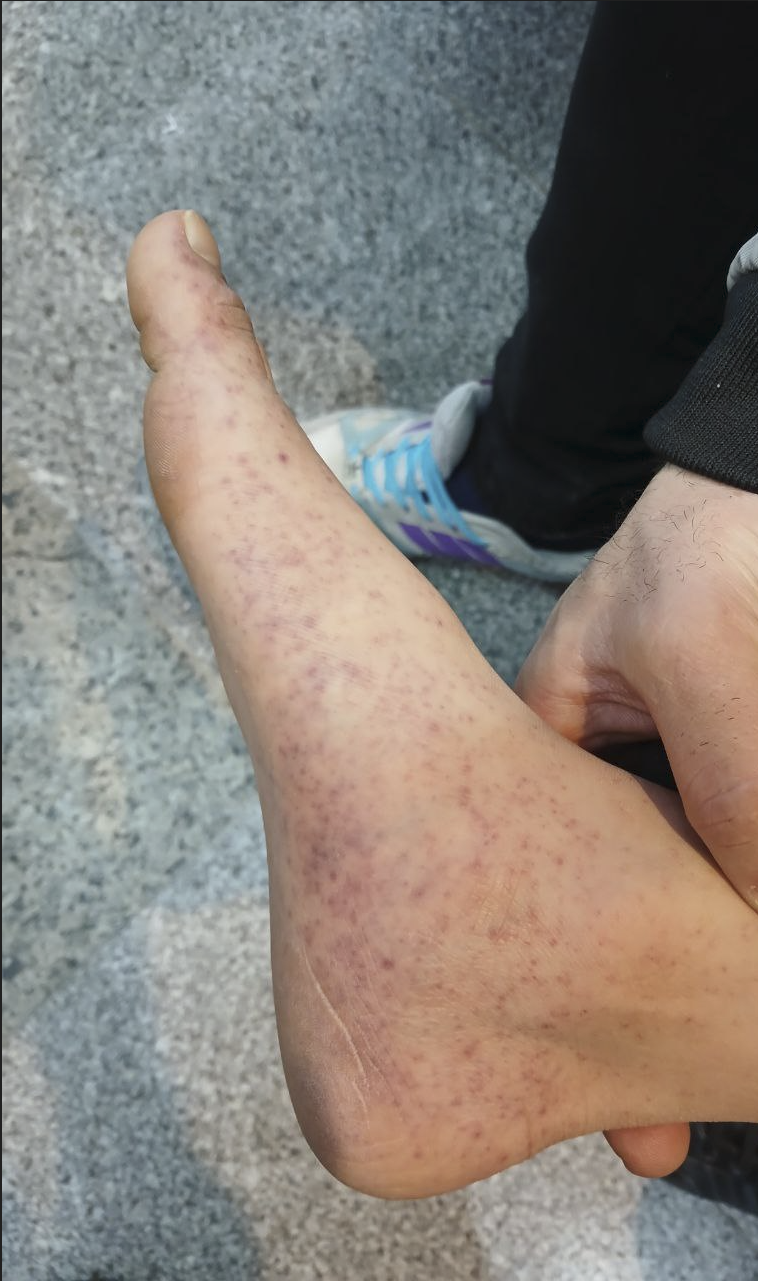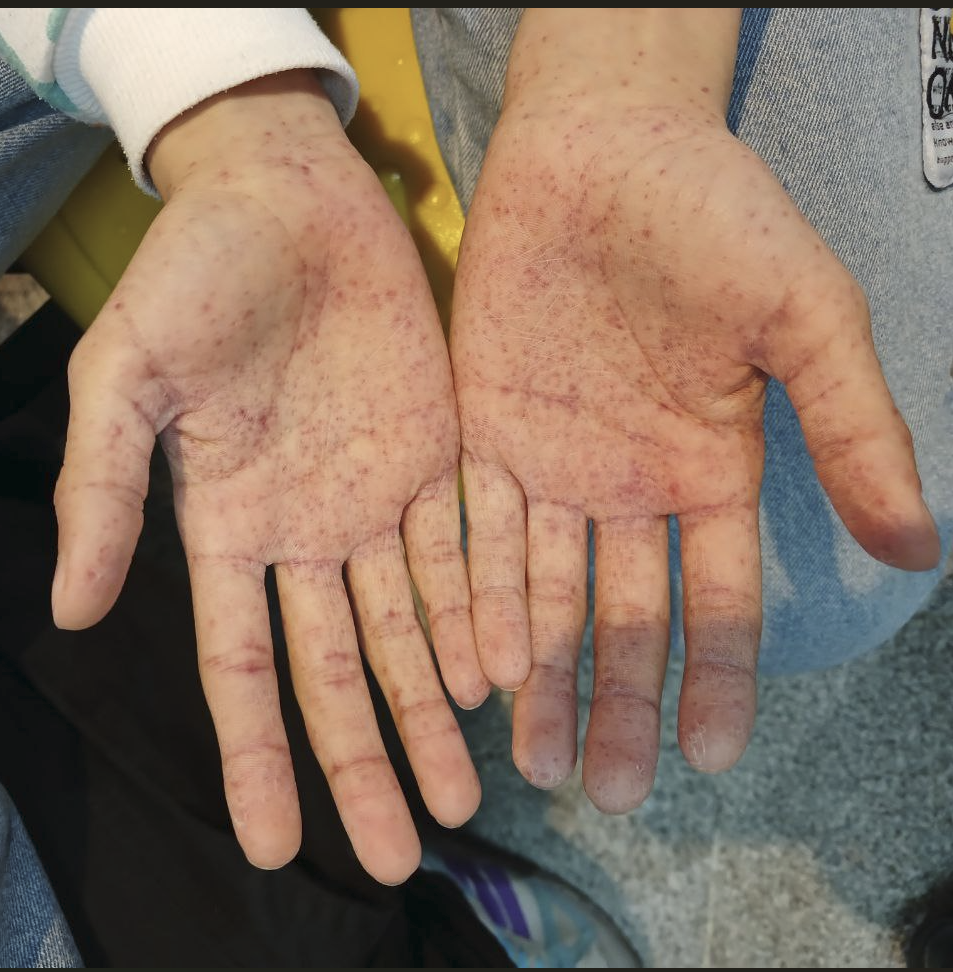
Sepideh Darougar, Fariba Soleimannorouzi, Nima Pirestani, Sepideh Safardoost, Maryam Adib and Masoumeh Hemmatyar*
Department of Pediatrics, Faculty of Medicine, Tehran Medical Sciences, Islamic Azad University, Tehran, Iran.
*Corresponding Author: Masoumeh Hemmatyar, Department of Pediatrics, Faculty of Medicine, Tehran Medical Sciences, Islamic Azad University, Tehran, Iran.
Received Date: April 10, 2024
Accepted Date: May 06, 2024
Published Date: May 22, 2024
Citation: Sepideh Darougar, Fariba Soleimannorouzi, Nima Pirestani, Sepideh Safardoost, Maryam Adib and Masoumeh Hemmatyar. (2024) “A Report of an Unusual Presentation of Psittacosis in A Child with Papular-Purpuric Gloves and Socks Syndrome.”, International Journal of Medical Case Reports and Medical Research, 2(4); DOI: 10.61148/2994-6905/IJMCRMR/037.
Copyright: © 2024. Masoumeh Hemmatyar. This is an open access article distributed under the Creative Commons Attribution License, which permits unrestricted use, distribution, and reproduction in any medium, provided the original work is properly cited.
Careful evaluation of children with petechiae and purpura, particularly those who appear to be ill, helps to facilitate timely diagnosis. The most common disorders with petechial rash include invasive meningococcal disease, traumas, viral illnesses, and Henoch-Schonlein purpura, falling into vascular integrity disruption category as well as idiopathic thrombocytopenic purpura, falling into disorders hemostasis category. Here we report a previously healthy 11-year-old boy referred to the hospital for fever, cough, and petechial eruptions. Symptoms had initiated five days prior to admission. These symptoms included fever, cough, malaise, and petechiae starting on both palms and soles with a “socks and gloves” distribution along with itching. The eruptions were palpable and did not fade or blanch upon pressure. He had a history of keeping a parrot at home with a high level of close daily contact. Lab tests were normal except for a mild leukocytosis, and elevated ESR and CRP. The results of microbiological tests were negative for Influenza, COVID-19, EBV, Adenovirus, Parvovirus B19, Cytomegalovirus, Herpes simplex, Hepatitis B and C, HIV, Borrelia, and Brucellosis. Anti CCP, c-ANCA, and p-ANCA were within normal limits. While waiting for the lab results and watching the course of the disease, an empirical therapy with doxycycline was initiated due to the suspicion of psittacosis as a result of his contact with the aforementioned parrot. He showed a favorable response to the therapy after a week with gradual resolution of symptoms. PPGSS can be therefore regarded as a non-specific skin presentation of psittacosis.
Introduction:
Petechiae are nonblanching red or purple macules, maximally 1 to 2 mm in size, which occur as a result of bleeding from small capillaries into the skin. Purpura is larger than macule and may be tender or painful. The two main underlying causes of purpuric skin lesions in children are disruption in vascular integrity and hemostasis disorders. Careful evaluation of children with petechiae and purpura, particularly those who appear to be ill, helps to facilitate timely diagnosis. The most common disorders with petechial rash include invasive meningococcal disease, traumas, viral illnesses, and Henoch-Schonlein purpura, falling into vascular integrity disruption category as well as idiopathic thrombocytopenic purpura, falling into disorders hemostasis category [1]. Meningococcal infection has been reported with two cardinal manifestations of fever and non-blanching rash in 10% to 20% of affected children [2]. While unintentional trauma is frequently observed in children as a result of their high activity, other reasons, mainly child abuse, should not be neglected. The most common reported viruses associated with the occurrence of purpuric rashes include respiratory syncytial virus (RSV), Epstein-Barr virus (EBV), cytomegalovirus (CMV), enterovirus, adenovirus, and parvovirus B19 [3]. Henokh-Shonlein purpura is a small vessel vasculitis characterized by palpable purpura, arthritis, abdominal pain, and nephritis. On the other hand, petechial rash is the hallmark of idiopathic thrombocytopenic purpura (ITP). However, as the name would suggest, patients develop low platelet counts and usually deal with easy bruising, nose bleeding, and in the most severe cases internal bleeding. It is also noteworthy that these rashes are not palpable under such circumstances.
This study is a case report concerning a child presenting with high grade fever, cough, and palpable purpura with a “socks and gloves” distribution, the skin lesions of which resemble those of Henokh-Shonlein at the first sight, yet the final diagnosis was psittacosis.
Case Report:
A previously healthy 11-year-old boy referred to the hospital for fever, cough, and petechial eruptions. Symptoms had initiated five days prior to admission. These symptoms included fever, cough, malaise, and petechiae starting on both palms and soles with a “socks and gloves” distribution along with itching. The eruptions were palpable and did not fade or blanch upon pressure (Figures 1-3).

Figure 1

Figure 2

Figure 3
Due to the severity of his signs and symptoms and progression of the skin lesions to the perioral area and elbow skin, the patient was admitted to the pediatric ward of Amir Hospital, Tehran, Iran. His physical examination showed his general good health condition, except his high body temperature of 39.4℃ at the time of admission. In addition to the above-mentioned purpuric papules, there were also small, ruptured vesicles (< 2cm) with honey-colored crust around his mouth indicative of impetigo. An interview with his mother revealed that he owned a parrot and was constantly in close contact with this bird.
Laboratory tests showed a normal complete blood count (WBC: 7700, Hgb: 12.4, Platelets:211000). Two days after the first test, WBC rose to 13200 (Neutrophil: 82%, Lymphocyte: 13%, Monocyte: 3%, and Eosinophil: 2%). At the time of admission, ESR was reported 53mm/h, which rose to 99 mm/h after two days. Similarly, CRP was 8.1 mg/L on the day of admission and rose to 17.1 after two days. The fecal occult blood as well as blood, urine, and stool cultures were all negative. The urine analysis was also normal. ASO titer was reported above 500 U/ml. The results of microbiological tests were negative for Influenza, COVID-19, EBV, Adenovirus, Parvovirus B19, Cytomegalovirus, Herpes simplex, Hepatitis B and C, HIV, Borrelia, and Brucellosis. Anti CCP, c-ANCA, and p-ANCA were within normal limits. While waiting for the lab results and watching the course of the disease, an empirical therapy with doxycycline was initiated due to the suspicion of psittacosis as a result of his contact with the aforementioned parrot. The patient’s symptoms gradually improved and he was therefore discharged in good general conditions on the 6th day of admission.
Discussion:
Chlamydia psittaci is an intracellular pathogen infecting a wide range of birds as hosts, which may cause severe diseases when transmitted to humans [4]. This infection can be transmitted to humans through direct inhalation of bird droppings or secretions as well as the plumage aerosol of the infected birds [5, 6]. As this infection is rare in children, correct, timely diagnosis is quite challenging [5]. Patients may have complications in different involved organs. Dermatologic manifestations include a facial macular rash known as “Horder spots” as well as erythema nodosum, erythema multiforme, erythema marginatum, and panniculitis.
Because of the intracellular nature of the pathogen, there is no accurate diagnostic technique [5]. In severe cases which fail to respond to appropriate treatment or when complications are developed, lab confirmations are deemed essential [6]. PCR and serology are recommended for detection of C. psittaci in the lower respiratory tract and other clinical specimens [7]. Metagenomic data from next generation sequencing (mNGS) has an acceptable sensitivity and can be used in the case of negative serological tests. Fifteen genotypes of C. psittaci, which may present with different clinical manifestations, are already identified [7]. This variety in clinical and laboratory diagnosis of psittacosis is indeed another source of diagnostic difficulty.
In this study, a child was admitted to the pediatric ward of Amir Hospital in Tehran due to palpable petechiae with a “socks and gloves” distribution as well as similar perioral involvement. At the first glance, the skin lesions resembled the petechiae in Henoch-Shonlein purpura, but not all the manifestations of the patient were in line with the criteria published in 2010 by EULAR, PINTO, and PRES, in which HSP diagnosis is defined by the presence of nonthrombocytopenic palpable purpura with at least one of the following: diffuse abdominal pain, vasculitis or proliferative glomerulonephritis with IgA deposition on the skin or renal biopsy specimens, arthritis or arthralgia, or renal involvement with hematuria or proteinuria [8]. The patient only showed palpable purpura without the accompanying criteria mentioned above. Furthermore, his lab tests did not show any fecal occult blood, hematuria, and proteinuria. HSP was, therefore, excluded from our differential diagnosis list. Considering the distribution pattern of the skin lesions, papular purpuric gloves and socks syndrome (PPGSS) was suggested, but its cause and management were yet to be investigated. In those patients without any prior health issues, the symptoms of PPGSS are generally mild and self-limited, usually resolved in 1 to 2 weeks [9, 10]. The same condition applied to the patient in this study.
Upon the literature review, case reports of patients with the same pattern of petechial rash distribution with different viral etiologies, particularly parvovirus B19, were found [9]. Therefore, various viral infections were evaluated by different appropriate and available serological and PCR methods, the results of which were all negative. Despite the rare reports of PPGSS with influenza [9], EBV [11], and COVID-19, PCR and serological tests were performed for these infections as well. The results of these tests were also negative.
The possibility of cutaneous vasculitis associated with systemic vasculitic syndromes with various predilections for small, medium, and large vessel involvements were also taken into consideration. However, the lab test results were all negative. In addition, the increased serum level of ASO was attributed to the patient’s perioral impetigo.
Following the patient’s mother’s remark concerning the patient’s direct, constant contact with a parrot and in light of the fact that his clinical signs and symptoms were similar to those of psittacosis, we started empirical therapy while waiting for the lab results. Soon after the treatment, the fever and cough subsided, the skin lesions were faded gradually, and CRP declined to normal levels. The improvements in the patient’s condition were subsequently and logically attributed to the treatment.
It is noteworthy that due to the shortness of the diagnostic tools, including mNGS, in our country, our diagnosis was predominantly based on the clinical presentations as well as an appropriate response to the empirical therapy.
In conclusion, the current study indicates that the PPGSS presentation of petechial rashes in children may not be solely confined to viral infections. Further studies are required to confirm such skin presentations in this disease.
Consent for Publication: Written informed consent was obtained from the patient’s parents for publication of this case report and any accompanying images.